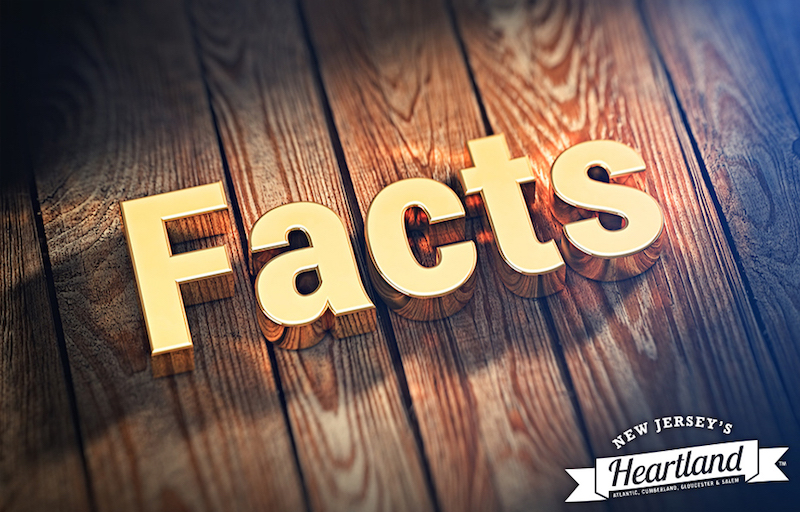NJ Heartland Facts: Cumberland County Edition


There are a lot of interesting “facts” about the area we call New Jersey’s Heartland that many people who live and work in our four-county region don’t know. Some are marginal, some are remarkable, but most are really pretty interesting.
For this second edition of “Heartland Facts,” we’re focusing on Cumberland County—which had its own “Tea Party” and has its own Liberty Bell (in the key of F). It is home to the town that was once known as the “Oyster Capital of the World” (the same town that had more millionaires per square mile than anywhere else in the nation).
The County also gave birth to New Jersey’s first regular newspaper, has 40 miles of Delaware Bay coastline, and is home to the state’s official Tall Ship. It has twice been voted one of the “best places to live in New Jersey” by a national publication.
So, here are three-dozen odds and ends that you can use to fascinate your friends when you’re talking about New Jersey’s Heartland.
Did you know that:
- The County has twice been voted one of the “best places to live in New Jersey” by Money Magazine?
- The County occupies about 500 square miles, has more than 40 miles of Delaware Bay coastline?
- The County is home to 157,000 people, who live three cities, ten townships and one borough?
- The County includes New Jersey’s largest historic district, located within the city of Bridgeton with over 2,200 homes and buildings on the National Historic Register of Places?
- Bridgeton is also home to the George Woodruff Indian Museum, a native American exhibit containing more than 20,000 artifacts related to the Lenni Lenape tribe that inhabited the region as well as the Cohanzick Zoo, New Jersey’s first zoo established in 1934?
- In the autumn of 1774, the County had its own pre-revolution “Tea Party” one year after the Boston Tea Party. Inhabitants along the banks of Cohansey Creek were startled by the appearance of the British brig “Greyhound.” Sailing about four miles up the Cohansey, the brig stopped at the village of Greenwich, which was the first landing from its mouth, with a cargo of tea sent out by the East India Tea Company. The boxes of tea stored in the town for later shipment to Philadelphia were seized and burned on Market Square.
- The Greenwich Tea Party was the only act of violence against British authority in New Jersey prior to the Revolution?
- The County got its first meaningful permanent settlement in 1675 when John Fenwick purchased his tenth of West New Jersey from Lord John Berkeley?
- Until January 30, 1748, Cumberland County was part of Salem County?
- The County was given its name by Governor Jonathan Belcher in honor of his patron, William Augustus, Duke of Cumberland?
- The County was home to the town once known as the “Oyster Capital of the World;” as early as the 19th century, NJ was one of the four leading oyster-producing states in the nation and Port Norris became known as the “Oyster Capital of the World”?
- Legend says that, at that time, there were more millionaires per square mile in the Port Norris area than anywhere else in the nation?
- The County has—as befits the heart of the Garden State—an average growing season of 191 days, which is considered fairly long—enabling farmers to make very early plantings in the spring, and to rely on crops maturing late in the fall?
- The County has its own Liberty Bell (in the key of F); it was made in Bridgewater, England before 1776. It rang for liberty when the Declaration of Independence was signed, and was used as a warning signal during the War of 1812?
- The County gave birth to what many historians consider New Jersey’s first regular “newspaper”. The Plain Dealer, the first newspaper established in the state expressly for the purpose of supporting the drive for American liberty, appearing every Tuesday morning?
- The County got its official flag in 1955; it was designed by J. Meade Landis, with the buff and sky blue of the diagonally quartered portion of the flag representing the colors of the uniforms worn by the Continental troops in the Revolutionary War and the insignia of a bell in the central portion of deep blue representing the County’s own Liberty Bell?
- The County is home to New Jersey’s official Tall Ship, the schooner A.J. Meerwald, a restored oyster dredging schooner, whose home port is in Bivalve, Commercial Township?
- The County is home to a Federal Empowerment Zone and two Urban Enterprise Zones?
- The County sees more than 100,000 visitors a year in places like WheatonArts and the Cohanzick Zoo and literally millions of visitors a year travel New Jersey Routes 40, 47, and 55 through the County?
- Vineland was formed on July 1, 1952, through the merger of Landis Township and Vineland Borough, based on the results of a referendum held on February 5, 1952?
- After determining that the Vineland soil was well-suited for growing grapes (hence the name), founder Charles Landis started advertising to attract Italian grape growers to Vineland, offering 20 acres of land that had to be cleared and used to grow grapes. Thomas Bramwell Welch founded Welch’s Grape Juice and purchased the locally grown grapes to make “unfermented wine” (or grape juice)?
- The fertile ground also attracted the Progresso soup company, which still advertises its Vineland roots in its television commercials?
- Throughout the first half of the 20th century, most of Vineland city was involved in the poultry industry, which led to the city being dubbed “The Egg Basket of America”?
- Of all the municipalities in New Jersey to hold the label of “city,” Vineland is the largest in total area, with a total of 69.029 square miles?
- Vineland’s Delsea Drive-In, located on Route 47 (Delsea Drive) north of County Route 552, is the only drive-in theater in the state of New Jersey—the state in which drive-ins were first created in 1932?
- The Palace of Depression was built in Vineland by the eccentric George Daynor, a former Alaska gold miner who lost his fortune in the Wall Street Crash of 1929; it was known as “The Strangest House in the World” or the “Home of Junk”, and was said tom have been built as “ testament of willpower against the effects of The Great Depression”?
- In 1790, Joseph Smith and Henry Drinker purchased 24,000 acres (97 km2) of land known as the Union Mills Tract. They formed the Union Estates Company, built lumber mills along the Maurice River and established a dam to power these new mills. Joseph Buck, an American Revolutionary War veteran who served under General George Washington, was part of a group that purchased the land in the area in 1795 and laid out the plans for what would become Millville?
- In 1806, an Irish immigrant, James Lee, opened the area’s first glass factory, making use of the large amounts of silica sand and the ample wood that could be used to operate the plant?
- In the early 1850s, the Smith and Wood Iron Foundry and New Jersey Mills were constructed. In 1860, a bleachery and dye house were added to New Jersey Mills, which then became Millville Manufacturing?
- David Wood then constructed a dam, forming the largest man-made lake in the state, which powered the entire manufacturing organization?
- The Millville Airport was dedicated “America’s First Defense Airport” on August 2, 1941, by local, state, and federal officials. In less than a year, construction of military base facilities began, and in January 1943, the Millville Army Air Field opened as a gunnery school for fighter pilots.
- Gunnery training began with Curtiss P-40 Warhawk aircraft, but after a few weeks was changed over to the Republic P-47 Thunderbolt. During its three-year existence, thousands of soldiers and civilians served at the Millville Army Field, with about 1,500 pilots receiving advanced fighter training in the Thunderbolt?
- The New Jersey Motorsports Park is located on 500 acres immediately adjacent to the Millville Airport. New Jersey Motorsports Park embraced this rich history by naming its marquee 2.25-mile racetrack “Thunderbolt Raceway.” The 1.9-mile road course, Lightning Raceway, is named after the P-38 Lightning, a WWII fighter aircraft?
- While building the various structures at New Jersey Motorsports Park, many WWII artifacts were found and collected for display at the Millville Army Air Field Museum, located on the opposite side of the Millville Airport. The Bore Site range, located just outside Thunderbolt Raceway Paddock was used by Thunderbolt pilots during training as a range to calibrate their machine guns.
- Millville’s Mike Trout, nicknamed The Millville Meteor, was the American League Most Valuable Player (MVP) in 2014. He is also a four-time All-Star, and a two-time All-Star Game MVP since becoming a regular player in 2012.
- Trout was a first-round pick by the California Angels in the 2009 MLB draft and unanimously won the 2012 AL Rookie of the Year Award. Trout finished second in AL MVP voting in 2012, 2013 and 2015. In addition to being named Most Valuable Player in 2014, he won the 2014 AL Hank Aaron Award?

